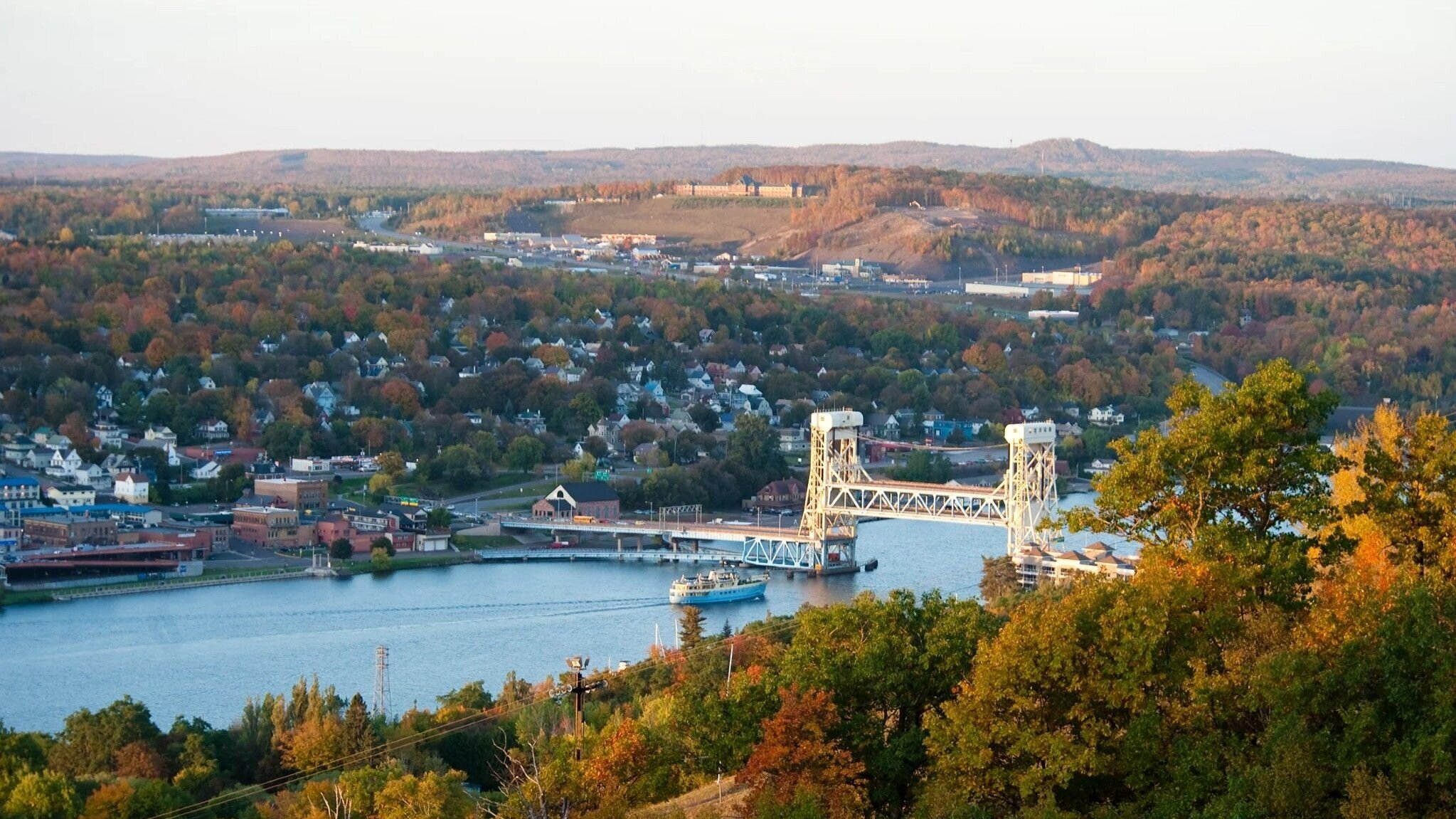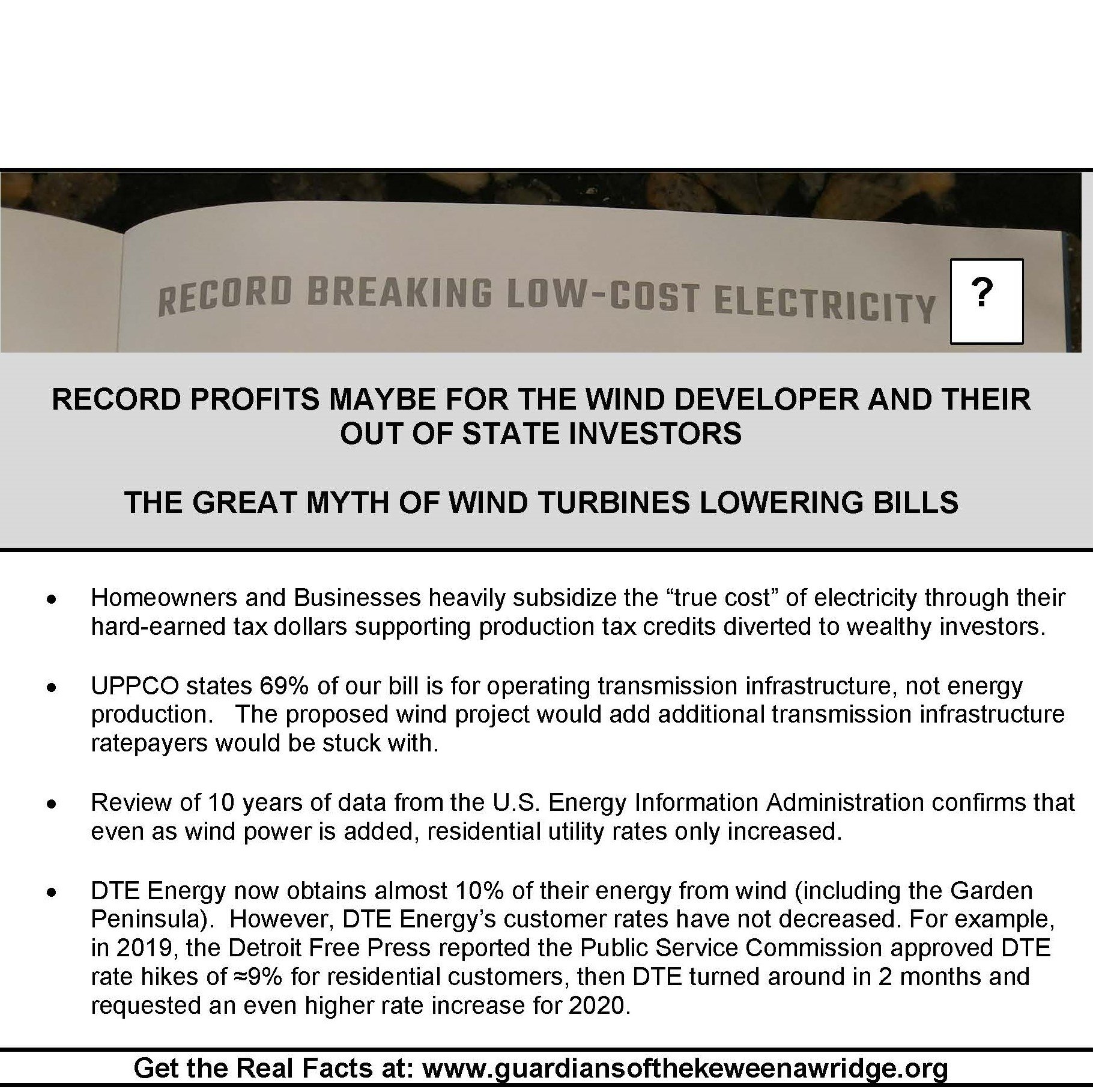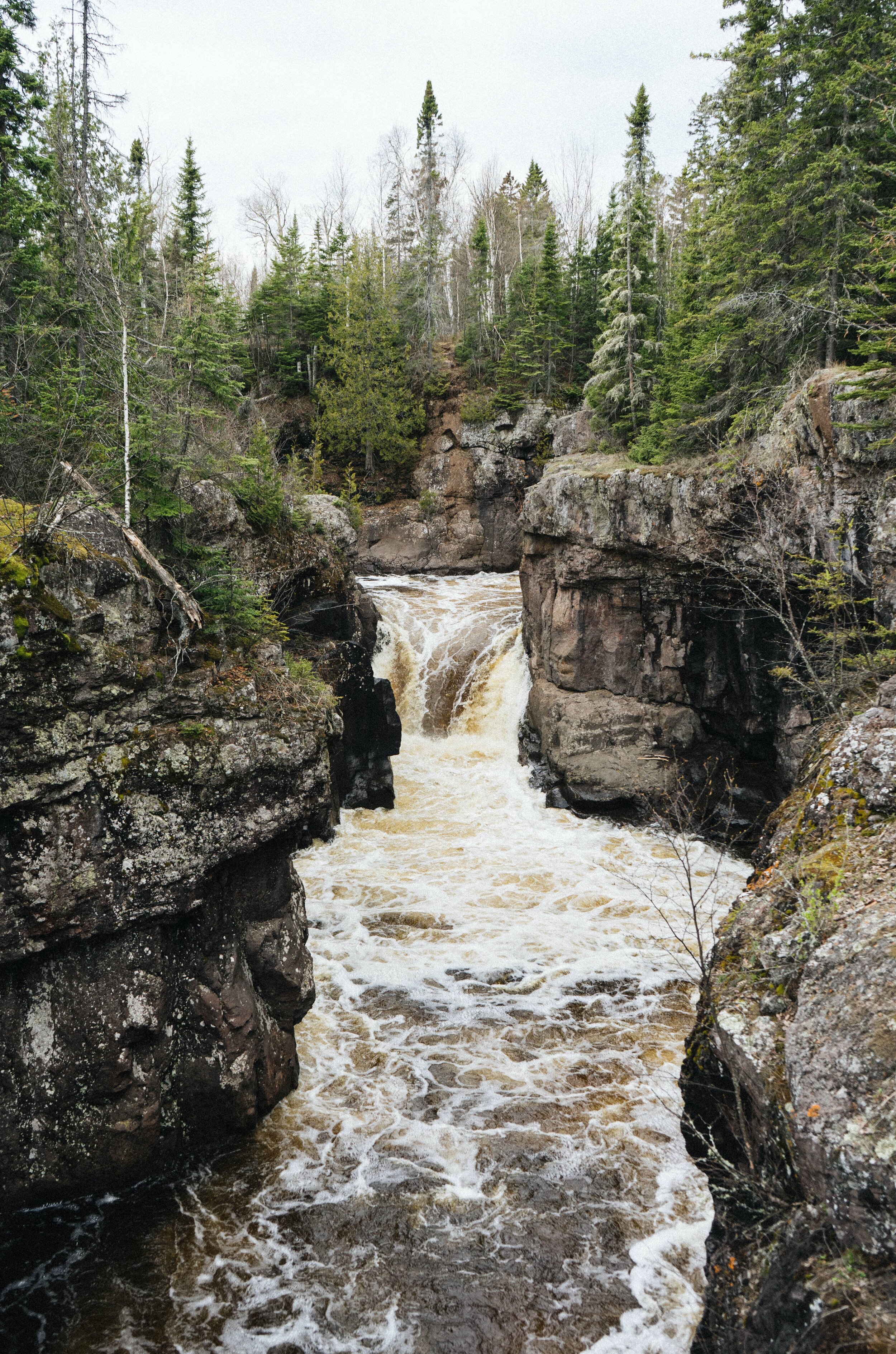
Why protect the Keweenaw Ridge from Industrial Wind Turbines?
Click here to learn What is the Keweenaw Ridge?
The local fight to preserve the Keweenaw Ridge from the economic, social, and environmental THREATS of Big Industrial Wind Facilities goes back to 2014 (see our News page). The Guardians of the Keweenaw Ridge was formed in early 2021. One purpose of the Guardians is to serve the common interests of residents, visitors, and friends of counties and townships located on or within site, of the Keweenaw Ridge of Michigan’s Upper Peninsula, by assisting in the collection of factors, opportunities, as well as threats to the Keweenaw Ridge and surrounding area located in Michigan’s Upper Peninsula.
The THREAT from BIG WIND was real, we worked very hard educating residents, visitors, and public officials. On July 30, 2021 the Michigan Department of Environment, Great Lakes, and Energy (EGLE) denied the most recent wind developer’s environmental permit for four reasons: 1) the project would have significant adverse effects on fish and wildlife and the natural resources of the state, 2) the project was not in the public interest and any benefits would not balance the reasonably foreseeable detriments, 3) the project would result in unacceptable disruptions to the aquatic resources, and 4) a feasible and prudent alternative exists.
We know the fight is not over. The developer has remained in the Western U.P. and has indicated their interest in continuing efforts to cut down trees and ban residents from land we hunt, fish, pick berries, enjoy wildlife, and recreate on. There is also an awareness now of the special place our dark skies provide to residents and visitors (versus the blinking lights of 600-foot plus towers).
Earlier this year we filed 20 pages of comments regarding the UPPCO Renewable Energy Plan (https://mi-psc.my.site.com/s/global-search/uppco%20rewewable%20energy%20plan). UPPCO’s plan omitted all discussion on the large scale local opposition to BIG WIND (see news stories on that opposition). We provided the Michigan Public Service Commission with documentation that: 1) demonstrated the tremendous amount of opposition by local residents of the Western UP regarding their social, economic, and environmental concerns regarding industrial wind power projects in the area, 2) documented concerns raised by outside organizations (e.g., Scenic Michigan and the American Bird Conservancy), 3) showed why BIG WIND was a bad fit in our area according to “Site Wind Right Maps” (generated by the Nature Conservancy), 4) demonstrated the Highly Probable Conflict of Industrial Wind Facilities in our areas that are near locations of Bat Hibernacula supporting Threatened/Endangered Bat Populations, and, 5) showed the extensive scientific evidence published in peer reviewed scientific journals on negative impacts of industrial wind energy infrastructure.
We hope you enjoy the factual information on this web page. Please contact us with any questions you might have. SIgned, the Guardians
Here’s the background
(we won the first round but must remain diligent).
Placement of any technological infrastructure is all about context. The Keweenaw Ridge is just not appropriate for locating large scale industrial wind turbines. The towns, farms, and wildlife that live along, under, and within view of the ridge, have historical, cultural, economic, and environmental significance that will be harmed by placement of these gigantic industrial wind turbines.
The most recent proposal was in December, 2021. It proposed to place twelve 575-foot industrial wind turbines in Adams townships (an earlier failed proposal had 4 in Adams Township and 8 in Stanton Township; for the revised December 2021 proposal, Circle Power simply moved turbines across the Adams Township border, some now even closer to the residents residing along M26). (http://www.keweenawreport.com/featured/guardians-of-the-keweenaw-ridge-react-to-latest-scotia-wind-farm-push/)
We knew the height (575 feet is to the tip of the blade) and original locations because of public information provided to the Federal Aviation Administration (FAA). To place things in perspective, the iconic Quincy Mine Shaft Building is 120 feet high. This is the first of many proposals to install even greater numbers of large industrial wind turbines in the Keweenaw.
We were asked by the wind developer to watch a WUPPHR supported webinar. In the video, the lead speaker (Dr. Sarah Mills, University of Michigan) states if the goal is for substantial residential development or growth of tourism, wind may not be right. Dr. Mills further stated if potential home builders or tourists are drawn to the community because of your view, that is likely to change.
Scenic Michigan (a coalition of Michiganders from all walks of life who care passionately about protecting Michigan’s spectacular beauty) wrote about the proposed project “The nature of our work at Scenic Michigan is what has brought this wind turbine development to my attention. I am very familiar with the Keweenaw Peninsula and the natural resources that your county offers as one of Michigan’s most incredible scenic vistas. A development of this scale has the potential to diminish these views, which are nationally known as a fall color destination, snowmobiling and skiing attraction, and nationally recognized dark skies location. We are fearful that the installation of wind turbines will negatively impact these appealing attributes of the Keweenaw Peninsula; and that tourists, travelers along Lake Superior, and the residents and municipalities will have their experiences diminished.”
In addition, our home is not only a physical structure we sleep in, but also the places we hang out with family and friends, garden, hunt, fish, boat, & berry pick. All of us have trouble visualizing the size of these machines placed on the highest location in the Copper Country. The visual blight associated with these 575-foot machines will be seen from your home, farm, and garden; and places you drive, boat, hunt, fish, and recreate.
At township and county public meetings, residents voiced a long list of other concerns. They included loss of what makes the Keweenaw a special place to live, visit and own a business; using our tax dollars to support an outside company who will get rich while destroying what is so special to us; noticeable decreases in the value of our homes and property; noise, sleep disruption, flicker, and other negative health outcomes; loss of access to areas we hunt and fish and recreate on; displacement of local wildlife we hunt and view; and placement on a major Midwest spring migration route for eagles and other raptors; and further decimation of the local bat population. Furthermore, our area already produces a significant amount of renewable energy in the form of hydropower and many of us do what we can do to reduce our energy consumption.
Opposition was overwhelmingly against the proposed projects. For example, on October 8, 2021 the Daily Mining Gazette’s lead headline read: (Daily Mining Gazette October 8, 2021 & https://www.windaction.org/posts/52870)
The nays have it: Stanton Township survey finds 83% opposed to wind turbines
Promises of tax revenues were made and we pointed out that they are just that, promises. This is because the Michigan State Tax Commission ruled a few years ago in favor of wind turbine owners on how wind turbines are taxed. Furthermore, any wind turbine generated taxes will not increase the per student funding provided by the State. And a 2021 study by the Department of Energy’s Berkeley National Laboratory concluded turbine tax revenue does not result in increases in teacher salaries or decrease in class size. That study also concluded wind turbine produced local taxes have zero impact on rates of high school completion and student performance.
As we were told in the summer of 2021 at an Adams Township Board meeting, we are the guinea pigs.
What does the recent decision by MI EGLE mean? On July 30, 2021 the Michigan Department of Environment, Great Lakes, and Energy (EGLE) denied Circle Power’s environmental permit for four reasons: 1) the project would have significant adverse effects on fish and wildlife and the natural resources of the state, 2) the project was not in the public interest and any benefits would not balance the reasonably foreseeable detriments, 3) the project would result in unacceptable disruptions to the aquatic resources, and 4) a feasible and prudent alternative exists.
U.S. Fish and Wildlife has repeatedly informed Circle Power and the previous wind developer (documented as far back as 2017) that they re-site the project due to wildlife concerns. This is because federal guidelines on siting wind projects recommend avoiding critical areas of wildlife congregation. In the Copper Country, this includes a mountain ridge located on a peninsula and proximity to former copper mines where endangered cave bats hibernate and ridges where birds nest and migrate (as well as migrating tree bats).
Since this industrial wind project was proposed, we learned about studies conducted by university researchers in Europe that show the negative impacts of industrial solar farms on local bat populations.
Even with all of this public resistant and concern as well as comments provided by environmental officials, Circle Power would not back out, they stated they were already in ”negotiations” with Michgan EGLE and U.S. Fish and Wildlife. Their original application also showed they considered sites at Gratiot Lake and Toivola.
What does Local Control of Land Use in Adams Township Mean? If you are not aware, after extensive public input, in February 2022, the Adams Township Board unanimously approved a common sense land use ordinance that provides protection of the township’s historical, cultural, and natural resources, and protects the health, safety and welfare of community residents. That local control over land use was designed to specifically not restrict an individual’s right to use their property how they see fit, like having chickens or growing vegetable gardens (Keweenaw Report, February 8, 2022).
Since the fall of 2021, Circle Power used FOIA requests and letters from their downstate attorneys to apply subtle pressure to the township. This implied threat of legal action occurred even though Adams Township was just following their legal right to protect the health, safety and welfare of township residents.
Circle Power indicated shortly after this decision they are not stopping their failed project which has been rejected by local residents and U.S. Fish & Wildlife for over 7 years now. They state they continue to negotiate with Michigan EGLE and the U.S. Fish & Wildlife Service on siting their turbines. And when Circle Power notified Stanton Township in 2021 they are moving the whole project to Adams Township, they made it clear they might return to Stanton at any time.
We must remain vigilant. Remember, other townships in Michigan have kept industrial wind turbines out of their home. We can do the same.
Turbine height relative to known landmarks.
Proposed Siting of twelve 575-ft Turbines in Adams Township (as of December, 2021). More will arrive in our area with recently passed federal funding to update the national and regional electrical grid.
Large Scale Industrial Solar Plants: A new Threat to our Local Bat Populations
The industrial wind developer (Circle Power) then moved their attention to the former Groveland Mine Site in Felch, Norway, and Sagola Townships. They proposed installing 185,000 ground-mounted solar panels over 500 to 550 public and private acres (with construction proposed to start in 2025) (Iron Mountain Daily news, October 20, 2023).
That proposed project has also met local opposition for a host of reasons. And since that project has been proposed, research by a university experts on bats in Europe are now pointing out the negative impacts of industrial solar projects on bat populations.
There are many well established economic and health benefits in preserving slow reproducing, endangered/threatened bat populations in the Western U.P (they are important insect eaters, pollinators, and seed dispersers).
The Western U.P. is critically important destination for migratory tree bats and especially hibernating cave bats that utilize abandoned mines as winter hibernacula. Cave bats hibernating in abandoned mines may travel up to 250 miles away, thus making the Western U.P. critically important in protecting bats in the Upper Great Lakes region.
A recently released peer reviewed scientific journal article concluded “ground-mounted solar photovoltaic developments have a significant negative effect on bat activity.”
This new study (and others) point to potential adverse impacts from the proposed Groveland Mine industrial solar installation on threatened/endangered bats that hibernate, roost, forage, and commune within proximity to the proposed development location. This is because of the established risks of bats not tolerating human disturbance (that now include ground-mounted industrial solar photovoltaic developments).
Large Scale Ground-Mounted Solar Photovoltaic Systems have a Significant Negative Effect on Bat Activity. Only recently have studies been conducted to assess the impact of industrial solar farms on bat activity. A 2023 peer reviewed research study published in a high quality scientific journal used bat echolocation call recordings to conclude “ground-mounted solar photovoltaic developments have a significant negative effect on bat activity” (Tinsley et al., Renewable energies and biodiversity: Impact of ground-mounted solar photovoltaic sites on bat activity. Journal of Applied Ecology, 2023, DOI: 10.1111/1365-2664.1447). In fact, the activity of six of eight species/species groups analyzed was negatively affected by solar photovoltaic panels. The authors report their findings share similarities with a 2023 study from Hungary (Szabadi et al., The use of solar farms by bats in mosaic landscapes: Implications for conservation. Global Ecology and Conservation, 44, e02481, 2023).
Why do Large Scale Ground-Mounted Solar Photovoltaic Systems Impact Bat Activity? Tinsley et al. (2023) summarize that bats are known to be adversely impacted by anthropogenic noise, development associated with urbanized environments, the presence of smooth surfaces, and habitat fragmentation (i.e.., cutting of trees as proposed at the site). All of these factors are associated with ground-mounted industrial solar photovoltaic sites.
“The alteration of land use, land cover, soils and water resources result in changes to microclimate and hydrological conditions, which have direct and indirect impacts on bats.” Indirect impacts include bat collisions “with solar panels, as bats perceive smooth, horizontal surfaces as water, and will approach such surfaces attempting to drink. Indirect impacts of solar panels on bats may be subtler, with panels potentially increasing reflective temperature at night following a day of hot weather and also altering microclimate by blocking sunlight, rainfall and affecting drainage potentially reducing the availability of invertebrate prey. In addition bats may actively avoid solar photovoltaic sites, as a consequence of habitat loss and fragmentation as industrial solar energy can require large land footprints.”
Why are Developers Here?
A pro-wind 2009 Michigan State University study (https://www.michiganseagrant.org/downloads/research/projects/Intro-to-Wind-Energy.pdf) assessed the potential for industrial scale wind turbine development in the Western Upper Peninsula. That study specifically determined the number of potential wind turbines that could be installed in Houghton and Keweenaw counties (page 54 of the study). The proposed number will shock you; it is in the hundreds.
Then the State placed another bullseye on our communities by commissioning the University of Michigan to create a map (used by wind developers) that specifically shows the “easy targets” for wind development (https://www.michigan.gov/documents/energy/Wind_final_681759_7.pdf). If you look on the map, you will see the gray target counties in the UP, including Adams and Stanton townships. This is another reason we became easy targets for wind developers.
How many more Turbines? Do not believe any wind developer when they state these 12 proposed industrial turbines are all that is planned. No matter what Circle Power (or other developers) state, this first proposal of 12 turbines will be followed by more. There are two reasons for this.
First, out-of-area developers and Wall Street and London investors get quite wealthy from erecting these machines.
Second, plans are already in place to update the national electrical grid to accommodate more industrial wind turbines. Remember the $1.2 trillion Infrastructure Investment and Jobs Act passed by Congress and signed into law by the President late last year? The package provides approximately $65 billion for energy and electric grid development. These billions of dollars will be used to update the national electrical grid which includes the electrical grid serving the Midwest.
Furthermore, you probably did not know that Michigan’s Thumb started with a couple dozen turbines in 2008. They now have 836 turbines! Huron County alone has 472 active wind turbines (https://thumbwind.com/michigan-wind-farm-map/)
“This is an effort for them to come to get their foot in the door because this is something that has been studied for many years up here. I myself have had direct contact from some of these companies trying to do advanced work for sites for wind farm generation. Let me tell you, they may be landing in Adams or Stanton Township but they are planning on marching the spine from Keweenaw down to Ontonagon.”

The wind developer has shown a few “artist renditions” of what turbines will look like, choosing select locations in low lying areas. Is he kidding?
“if the goal is for substantial residential development or growth of tourism, wind may not be right”
“if potential home builders or tourists are drawn to the community because of your view, that is likely to change”
Dr. Sarah Mills, University of Michigan
Ready to join the fight?
You can join the fight to protect the Keweenaw Ridge by donating your time or money.

“Michigan’s Keweenaw Peninsula is imbued with a deep sense of place. Far from interstates or any major city centers, the Keweenaw offers a powerful experience for visitors who oft times return due to the simple beauty, and deep connection they feel to the landscape.”
— Vye, Erika, "Geoheritage of the Keweenaw Peninsula"
Stay in contact with us. Together we can make our voices heard.
Sign up to be the first to know about our events.






